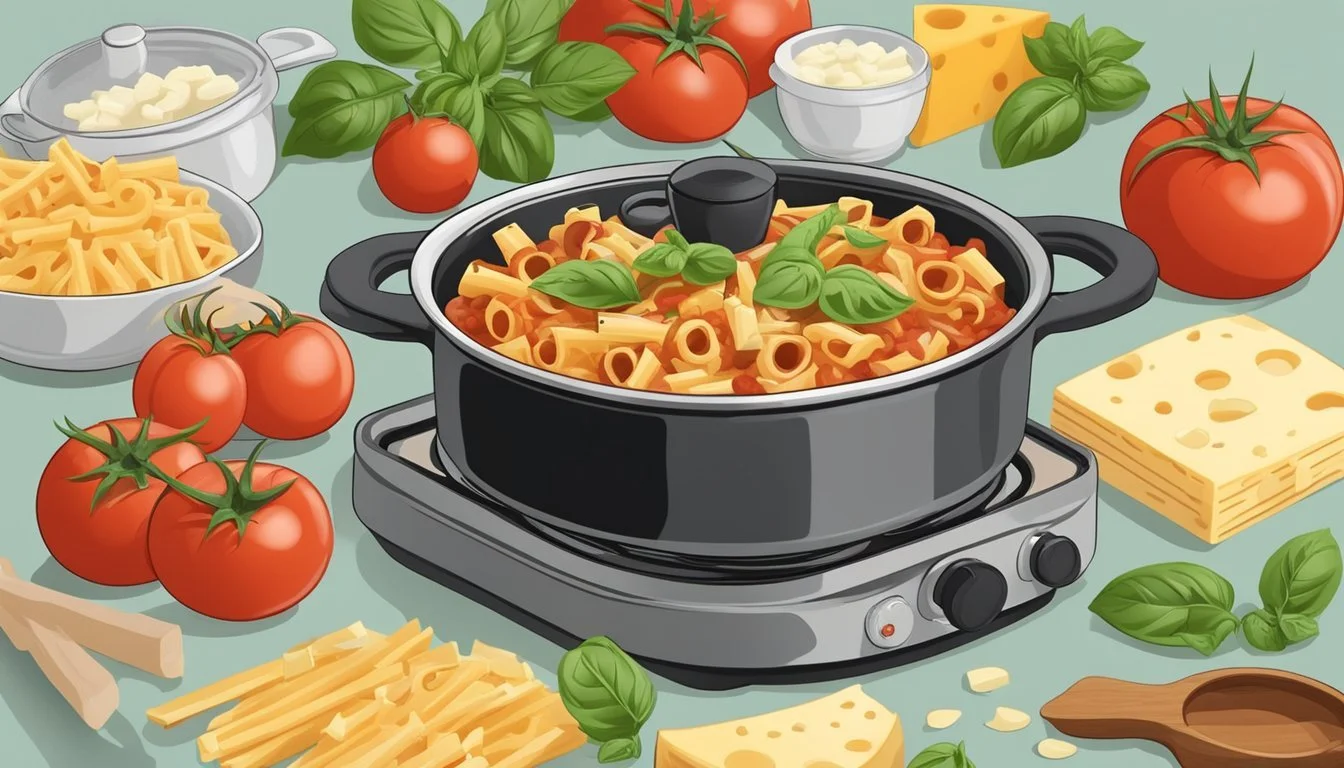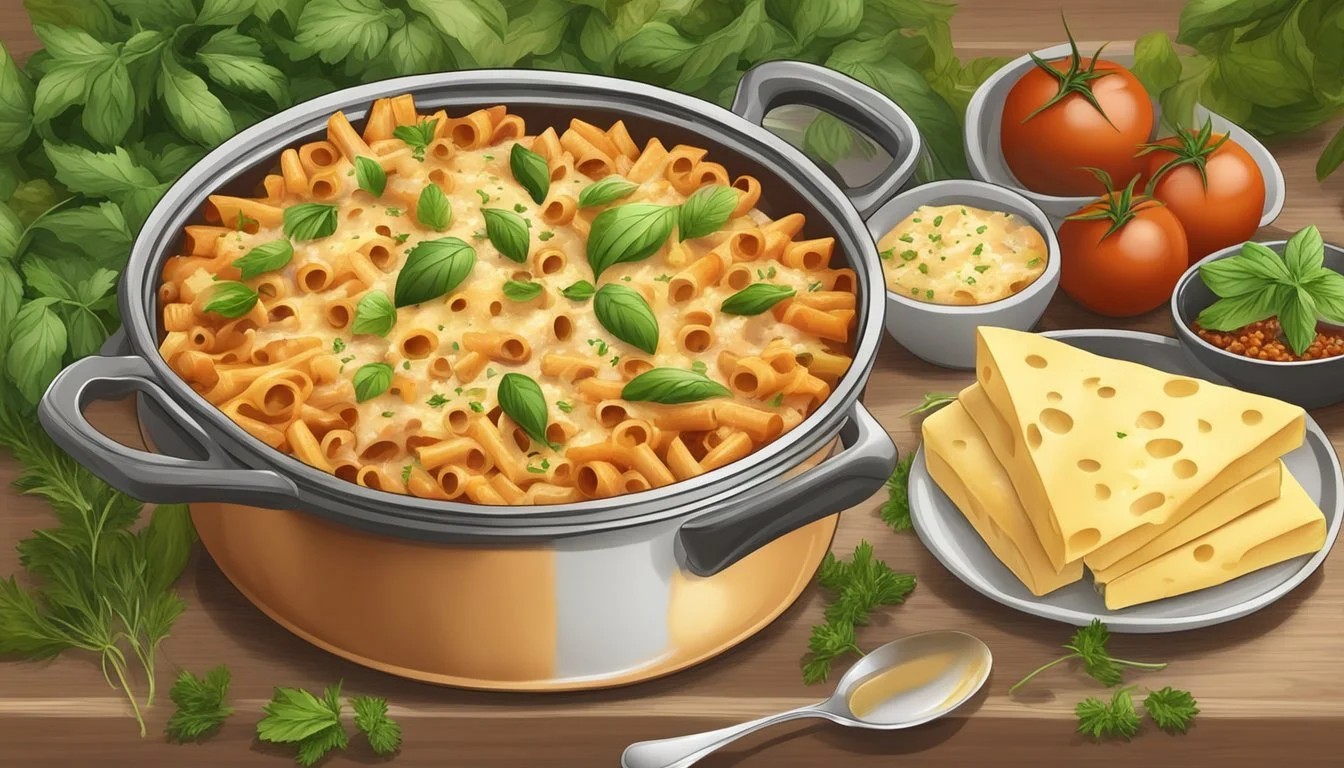The Stovetop "Baked" Ziti
Achieving Pasta Perfection in One Pot
Baked ziti is a beloved comfort food, a crowd-pleaser known for its hearty layers of cheese, pasta (What wine goes well with pasta?), and robust tomato sauce. Traditionally prepared in an oven, this dish brings together the rich flavors of Italian cuisine in a form that's ideal for gatherings and family dinners. However, the culinary landscape is ever-evolving, and a stovetop variation on this classic provides a quicker, yet equally delicious, alternative. By adapting the method for the stovetop, cooks can reduce preparation time without sacrificing the depth of flavor associated with the baked version.
This stovetop "baked" ziti involves simmering the pasta in a savory tomato sauce directly in the pot, where it absorbs the flavors and melds with cheeses to achieve a creamy and harmonious dish. The process begins with the building of a tomato base, sometimes starting with garlic and onions sautéed until soft, which then becomes the bedrock upon which the rest of the dish is built. Diced or crushed tomatoes are simmered to a thicker consistency, allowing the sweetness and acidity to concentrate before pasta is introduced to the mix.
Cheese is integral to baked ziti, and the stovetop method is no different. Once the pasta is tender, having absorbed the tomato sauce, a mixture of cheeses such as mozzarella and Parmesan is stirred in, resulting in a silky, stringy texture reminiscent of the oven-baked classic. Some recipes call for a final touch of creaminess from heavy cream or a dollop of ricotta cheese to add richness to the dish. This stovetop rendition of baked ziti stands as a testament to the adaptability of traditional recipes to modern cooking techniques, delivering the same satisfaction with a fraction of the effort.
Choosing Your Ingredients
Crafting a scrumptious Stovetop "Baked" Ziti begins with selecting high-quality ingredients that meld together in harmony, from the perfect pasta to the finest cheeses, and a sauce enriched with flavorful aromatics and seasonings.
Pasta Selection
The cornerstone of any pasta dish is the pasta itself. Ziti pasta, a tube-shaped pasta with smooth sides, is traditional for this dish, but penne can be used as a substitute. The ziti's substantial body is ideal for absorbing the sauce and cheeses. Look for:
Ziti, ideally ziti pasta, which is traditional
Penne, if ziti is unavailable
The Cheese Trio
The cheeses lend creamy, velvety textures and rich flavors to the dish. A trio of cheeses is typically used:
Shredded mozzarella cheese: for a satisfying melt
Preferably whole milk mozzarella cheese for more creaminess
Cubed mozzarella is an alternative for a chunkier cheese presence
Ricotta cheese: to provide a delicate, fluffy texture
Whole milk ricotta is recommended for its richer taste
Grated Parmesan cheese: for a sharp, savory finish
Freshly grated Parmesan elevates the dish’s flavor profile
Sauce and Flavor Enhancers
The sauce acts as a canvas, carrying the flavors of the other components. Essential items include:
Crushed tomatoes or high-quality marinara sauce, for a robust tomato base
Olive oil, specifically extra-virgin olive oil, for sautéing
Chopped onions and minced garlic, sautéed till aromatic
For meat lovers, cooked Italian sausage offers a hearty addition.
Additional Seasonings
Seasoning correctly is critical for a flavorful dish. Use:
Salt (preferably kosher salt) and black pepper to taste
Basil - fresh basil leaves or dried basil for a fragrant touch
Oregano - either dried oregano or fresh, to complement the basil
A pinch of red pepper flakes - for a subtle heat that doesn’t overpower
Maintaining the balance between the ingredients is key to ensuring each forkful is as delicious as the last.
Preparing to Cook
Before starting, it's essential to assemble all the ingredients and cooking vessels needed for a one-pot stovetop "baked" ziti. This section will guide you through the initial steps, cooking sequence, and combining elements to ensure pasta perfection.
Getting Started
One must first select an oven-safe skillet, such as a cast iron skillet or a Dutch oven, which will allow for both sautéing and baking the pasta in the same pot. Gather ingredients including ground beef or a substitute like ground turkey or Italian sausage, vegetables for added nutrition, marinara sauce, water, and shredded cheese for the top layer. Pasta like ziti should be on hand, as well as cream, to add richness to the dish.
The Cooking Sequence
Begin by cooking the ground beef over medium heat until lightly browned. Additional flavor builders like minced garlic and diced tomatoes can be added and sautéed until fragrant. These initial steps set the foundation for layers of flavor. Following this, the pasta and water are combined with the seasoned meat and brought to a simmer. It's crucial to cover the skillet to allow the pasta to cook evenly and soak up the savory tastes.
Combining Elements
Once the pasta is nearly cooked, it's time to incorporate the creamy elements. Stir in heavy cream and select cheeses to create an indulgent, cohesive mixture. This step is highly adaptable; whether one prefers a classic cheese combination or a creative twist, the skillet affords easy mixing. The final touch is a generous topping of shredded cheese, which will melt into a delectable, bubbly layer when the skillet is transferred to the oven to bake.
Finishing and Baking
Once the ziti pasta is tender and the sauce has thickened, it is time to add the final touches and transition to baking. This stage is crucial for achieving the delightful, golden crust that characterizes an irresistible baked ziti dish.
Ready to Bake
Before the baked ziti can enter the oven, one should ensure that the cast iron skillet or any other oven-safe skillet utilized is filled with the tender pasta and rich sauce mixture. Distributing grated Parmesan evenly across the top layer adds a sharp, savory note to the dish, which is complemented by the shredded mozzarella cheese known for its meltability and stretchy texture. Covering the skillet with aluminum foil is an essential step to prevent the cheese from burning and to promote even cooking.
The Baking Process
The skillet should be placed in a preheated oven at 350°F (175°C) to bake. The baked ziti recipe typically calls for a baking duration until the dish is bubbling around the edges, which usually takes about 20-25 minutes.
For a golden and crispy cheese topping, removing the aluminum foil in the last few minutes and setting the oven to broil will allow the cheese to achieve a desirable color and texture. Monitoring closely during broiling is important as the cheese can go from perfectly golden to burnt quite quickly.
The dish should rest for a few minutes after baking to allow the flavors to meld and the cheese to set slightly, making for an easier serving process.
Serving Suggestions
When presenting Stovetop "Baked" Ziti, the goal is to complement the hearty flavors of the pasta with sides that enhance the dining experience.
Side Dishes
Salads: A side salad is a refreshing choice. Opt for light vinaigrettes to contrast with the richness of the ziti.
Classic garden salad
Arugula with a lemon vinaigrette
Vegetables: Steamed or roasted vegetables (What wine goes well with roasted vegetables?) provide a healthful balance to the meal.
Sautéed green beans
Bread: Warm, crusty bread complements the ziti well, especially when it soaks up the sauce.
Garlic bread with melted butter and minced garlic
Breadsticks, ideally with a sprinkle of Parmesan
Presenting the Dish
Herbs: Garnish with fresh basil leaves right before serving to add a pop of color and freshness.
Cheese: Ensure the mozzarella on top is bubbling and golden-brown to entice diners visually.
Plating: Serve the ziti directly from the pot for a casual family-style meal or plate individually for a more formal presentation.
Nutrition and Dietary Adaptations
When preparing Stovetop "Baked" Ziti, it's essential to consider its nutrition profile and how the dish can be modified to suit various dietary needs. This section provides specific guidance on the nutritional content, vegetarian adaptations, and alternatives for different diets.
Nutritional Information
Stovetop "Baked" Ziti is traditionally a calorie-dense dish, often containing pasta, cheese, and meat. However, calorie contents can vary widely depending on the ingredients used. A typical serving could average between 400 to 600 calories. To understand the health impact, one should note that the dish can be high in saturated fats and carbohydrates due to cheeses and pasta. For a healthier version, cooks may choose low-fat cheeses, lean proteins like turkey, or even plant-based substitutes. Additionally, incorporating vegetables can boost fiber and nutrient content.
Making It Vegetarian
To adapt Stovetop "Baked" Ziti to a vegetarian diet, one can replace the traditional ground meat with plant-based proteins or vegetables such as mushrooms, spinach, or zucchini. Vegetarians might also consider using cottage cheese as a substitute for ricotta, providing a similar texture with potentially less fat.
Protein substitutes:
Lentils
Quinoa
Tempeh (What wine goes well with tempeh?)
Cheese substitutes:
Ricotta-style almond cheese
Soy-based mozzarella
Nutritional yeast (for a cheesy flavor)
Alternative Diet Options
For those adhering to specific dietary plans, Stovetop "Baked" Ziti can be modified in several ways:
Replace pasta with zucchini noodles or cauliflower.
Use an alfredo sauce base, typically lower in carbs than tomato-based sauces. (What wine goes well with tomato-based sauces?)
Gluten-Free Diets:
Choose gluten-free pasta options.
Ensure that all sauces and added ingredients are certified gluten-free.
Dairy-Free Diets:
Substitute cheese with vegan cheese options made from plant-based oils or nuts.
Forgo cheese entirely and opt for a rich tomato sauce flavored with herbs.
Note: Always check specific product labels to ensure they meet dietary restrictions.
Storing and Reheating
Storing and reheating "Baked" Ziti made on the stovetop is straightforward, ensuring this easy dinner recipe remains just as delicious the next day.
Storing Leftovers: Once the Ziti has cooled, it can be transferred to an airtight container. In the refrigerator, the pasta will keep for up to 5 days. If one opts to freeze the dish, ensure it is packed tightly to avoid freezer burn. In the freezer, Ziti can last up to 3 months. Include layers of marinara and ricotta to retain the moisture and flavors.
Storage Location Duration Refrigerator Up to 5 days Freezer Up to 3 months
Reheating Instructions:
To reheat in the oven:
Preheat the oven to 350°F (175°C).
Place the Ziti in an oven-safe dish, ideally the same pot used for cooking if it is oven-safe.
Cover with aluminum foil to prevent drying out, preserving the moisture of the marinara and ricotta.
Heat for about 20 minutes, then uncover and heat for an additional 10-15 minutes until thoroughly warm and the cheese is slightly golden.
For a quicker method in a microwave:
Cover the Ziti and heat on high for intervals of 2 minutes, stirring in between until heated through.
It is important to ensure the Ziti reaches an internal temperature of 165°F (74°C), indicating it is safely reheated. Following these steps will help maintain the integrity of the one-pot Baked Ziti, making leftovers just as enjoyable as when it was freshly made.







